More than 700 bird species live in North America. Each has its own way of nesting and breeding. Knowing when birds nest helps us understand their life cycles.
Some birds start nesting in the winter, while others wait until late summer. This shows how birds adapt to their environments.
Key Takeaways
- Over 700 bird species breed in North America, exhibiting a wide range of nesting behaviors and schedules.
- Nesting seasons vary significantly among species and regions, ranging from winter to late summer.
- Most birds use daylight cues to time their breeding activities, coinciding with food availability.
- Factors like weather, latitude, and age influence the nesting patterns of different bird species.
- Nesting birds are protected by law, and disturbing them can result in hefty fines and imprisonment.
Understanding Bird Nesting Seasons and Patterns
Bird nesting is a complex and fascinating process. It varies a lot among different species and places. The timing of bird nesting is influenced by daylight, food, and specific needs of each species.
Factors Influencing Nesting Timing
Spring marks the start of bird nesting season. Many bird species work hard to have a successful nesting season. But, the exact timing depends on the species, location, and environment.
Regional Variations in Nesting Periods
Climate differences lead to variations in bird nesting seasons across regions. For example, birds in the south often start nesting earlier. This is because they have more food and better weather.
Impact of Climate on Nesting Cycles
Climate change is affecting many bird species’ nesting cycles. Changes in temperature and rain can make food harder to find. This can upset the balance of seasonal bird nesting.
“Over-disturbance of bird territories can lead to unsuccessful nesting seasons, as the birds expend substantial energy on defending their space rather than focusing on the critical tasks of mating, nest-building, and raising their young.”
It’s important to understand what affects bird nesting. Knowing the bird nesting calendar and patterns helps protect these important populations. By supporting conservation efforts, we can help our feathered friends thrive.
When is Nesting Season for Birds?
Many people think spring is the only time birds nest. But, the truth is more complex. Bird nesting patterns change a lot based on the bird and where it lives. Some birds start nesting in January, while others nest in late summer or fall.
Some birds, like great horned owls and ravens, start nesting early. Others, like American goldfinches and mourning doves, nest later, sometimes in June, July, or September.
The timing of when is nesting season for birds depends on food, daylight, and weather. Birds nest when food is plentiful to help their babies survive.
It’s key to know that not all nests can be removed. Nests of protected birds must stay untouched. Removing these nests can lead to big fines or even jail, as the California Department of Fish and Wildlife warns.
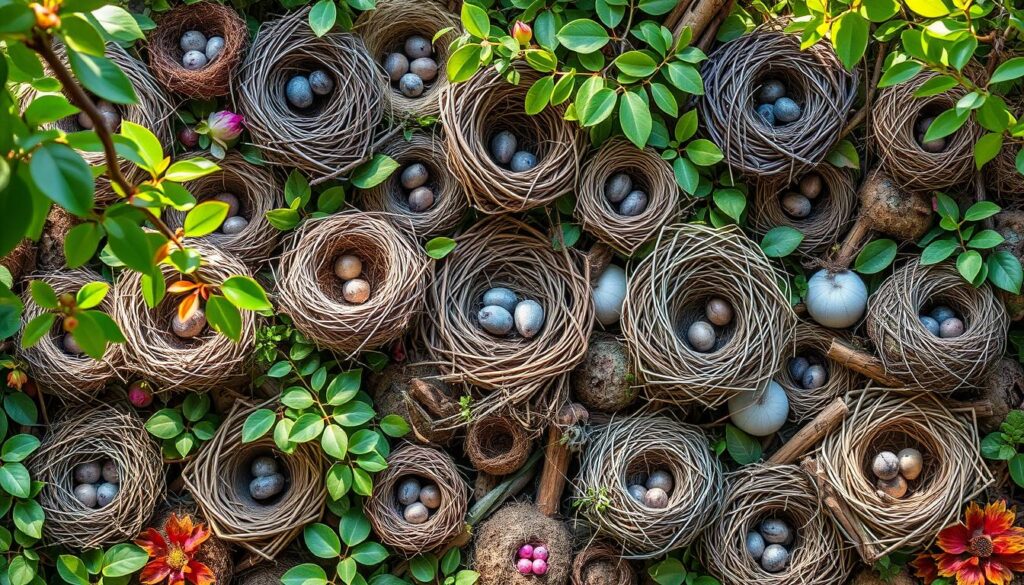
In short, bird nesting season is complex and changes a lot. Knowing about bird nesting helps us live better with them.
Early Season Nesters: Winter Warriors
When winter hits the northern hemisphere, a special group of birds starts their nesting season. These birds, known as “early season nesters” or “winter warriors,” brave the cold. They begin their breeding cycles before the spring birds do.
Great Horned Owls
The Great Horned Owl is one of the first to nest, starting as early as January or February. These big birds use the winter to their advantage. They have less competition for food, giving their chicks time to learn how to hunt before spring.
Bald Eagles
Bald Eagles also start their nesting early, especially in warmer places like Florida. They might lay eggs in October. This way, their chicks can fly before the summer heat. In colder areas, they nest in late winter to find more food.
Canada Jays
In the boreal forests of North America, the Canada Jay starts nesting in February. Known as the “Whiskey Jack,” these birds store food all year. This helps their chicks survive the harsh winter.
These birds show how they can survive the toughest weather. By nesting early, they get a jump on the breeding season. This gives their chicks the best chance to succeed.
Spring Nesting: Peak Season Activities
The spring season is when birds in North America are most active. As it gets warmer and sunnier, they start their nesting rituals. This time is filled with birds fighting for the best spots, showing off, and building nests.
Species like American Robins and Northern Cardinals often have more than one brood. The long days and plenty of food help them raise many chicks quickly.
Nest boxes in gardens and woodlots help birds like bluebirds and woodpeckers. Adding dry plant material and even pet fur can help them build their nests.
But spring nesting also comes with dangers. Cats can harm nestlings and eggs. Keeping an eye on nests and placing them safely can protect the birds.
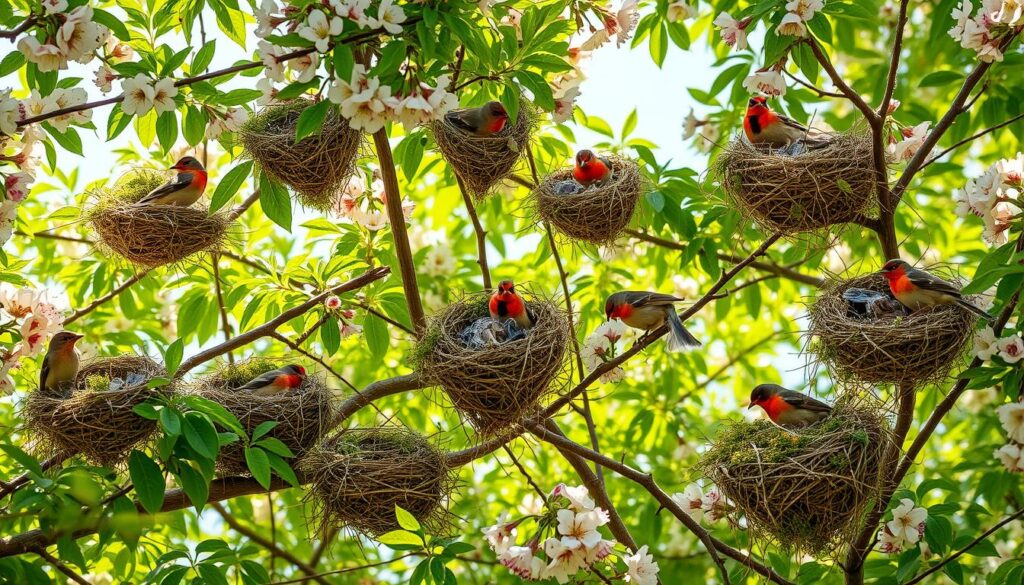
By knowing about spring bird nesting and helping, we can support our local birds. We can watch the amazing peak breeding season in our own backyards.
The Role of Daylight in Breeding Cycles
Daylight changes are key in controlling when birds breed. As daylight grows longer, birds start to get ready for breeding season.
Physiological Changes
More daylight makes birds’ bodies change. Their reproductive parts grow, and hormone levels shift. These changes tell birds it’s time to start breeding.
Territory Selection
Longer days also tell birds it’s time to pick and protect their breeding spots. This is vital for nesting. It makes sure they have what they need and a safe place for their young.
Research shows that avian breeding cycles are very sensitive to photoperiod effects on birds. Birds in captivity, with artificial light, often struggle to breed. The right light schedule and natural daylight help them breed better.
“Understanding the role of daylight in avian breeding cycles is crucial for both wildlife conservation and captive breeding programs.”
The link between daylight and bird breeding shows how delicate nature is. Studying bird behavior helps us protect and care for these amazing creatures.
Nest Building and Material Selection
The art of bird nest construction is truly amazing. Birds build nests in many ways, from simple to complex. They use materials like grass, leaves, and mud, and even things made by humans.
Where birds build their nests varies a lot. Some nests are on the ground, while others are high up in trees or on buildings. This choice helps keep eggs and babies safe from harm.
Building a nest can take anywhere from two days to two weeks. This depends on the bird’s experience, the weather, and what materials are available. Some birds, like woodpeckers, even add to their old nests, showing their cleverness.
The materials birds choose are very important for their survival. Birds like bluebirds and chickadees often use birdhouses. These provide a safe place for their young to grow. The nest’s materials and design are key to the birds’ success in raising their babies.
“Every spring, the bird returns to its nest, sometimes the same one, sometimes a new one, but it’s always a miracle.” – Robert Brault
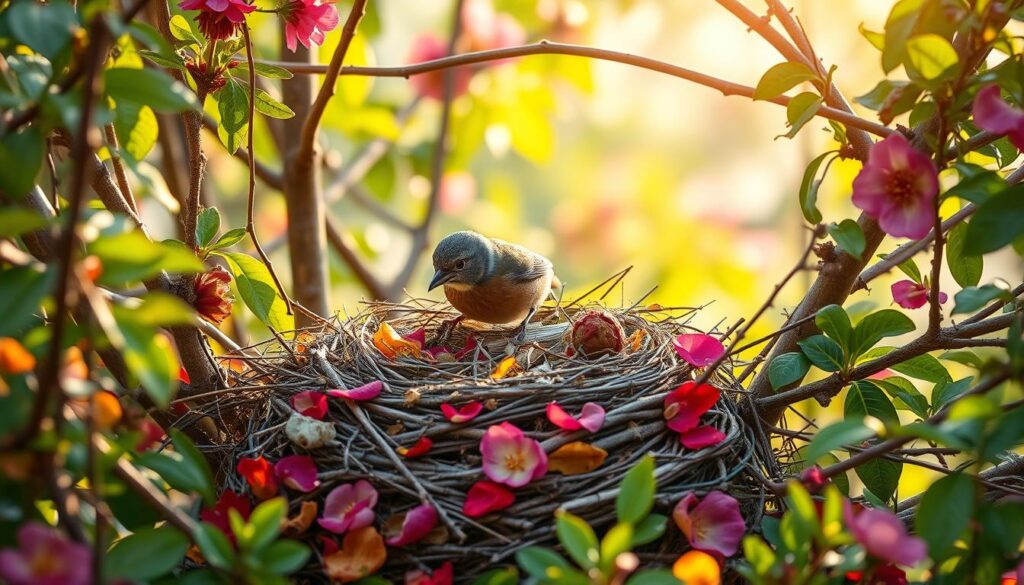
Birds’ nest-building shows their amazing adaptability and creativity. Watching them work reminds us of nature’s complexity and strength. It’s a chance to appreciate the beauty and resilience of our world.
Egg Laying Patterns and Clutch Sizes
The world of bird reproduction is full of interesting facts. Birds lay eggs in different ways and numbers. This is because of many factors like where they live, what resources they have, and how old the female bird is.
Variations in Egg Numbers
Some birds lay just 1-2 eggs, while others can lay up to 15. A study in Arizona and Argentina showed that birds in Arizona laid more eggs, about 4.61 per nest. In Argentina, it was 2.58 eggs per nest. This shows that birds lay more eggs as you move from the equator to the poles.
Incubation Periods
How long birds incubate their eggs also varies a lot. Bigger birds like raptors and waterfowl take longer, while smaller birds like songbirds take less time. A study in Russia found that weather affected when Booted Warblers and Whinchats laid their first eggs and how many they laid.
Learning about bird egg laying and clutch size variations helps us understand how birds adapt and survive. It shows us how different environments affect their ability to reproduce.
| Species | Clutch Size Range | Incubation Period (days) |
|---|---|---|
| Great Horned Owl | 1-4 eggs | 30-37 |
| Bald Eagle | 1-3 eggs | 34-36 |
| Canada Jay | 2-5 eggs | 16-18 |
| Northern Flicker | 3-12 eggs | 11-13 |
| Booted Warbler | 3-6 eggs | 12-14 |
| Whinchat | 4-6 eggs | 13-15 |
“As resource abundance increases during the non-breeding season, clutch size decreases.”
Late Season Nesters and Multiple Broods
Many bird species start nesting in the spring. But some, like American Goldfinches, wait until late summer. They build their nests when seed-bearing plants are abundant. Mourning Doves also have multiple broods, nesting well into the fall.
Late nesting can be advantageous for seed-eating species when food is plentiful. This way, birds raise their young when food is easy to find. It helps the parents and their offspring survive better.
- American Goldfinches often wait until June, July, or even September to start nesting, ensuring a steady food supply for their young.
- Mourning Doves are known for their ability to produce up to six broods in a year, particularly in southern regions, continuing to lay eggs into early fall.
- Other multiple-brooded species include American Robins, Eastern Bluebirds, and Northern Cardinals, which can raise 2-3 broods per season.
This flexibility in nesting patterns shows how birds adapt to their environments. It highlights the need to understand each species’ unique breeding behaviors.
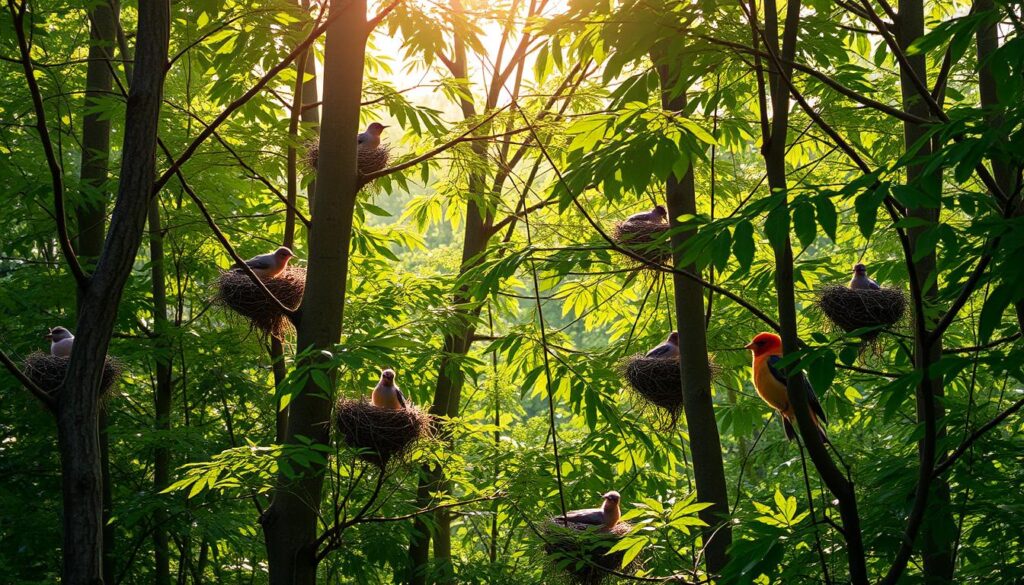
“The timing of nesting is crucial for the success of many bird species, and those that can take advantage of late-season opportunities often have a better chance of raising healthy young.”
Breeding Territory Selection and Defense
Birds pick their breeding territories for many reasons. They look for food, nesting sites, and safety from predators. The quality of a territory greatly affects a bird’s chance to breed successfully.
Habitat Requirements
Territories are defended because they have limited resources. According to Brown’s model from 1964, more birds mean more competition. This leads to aggression to get resources.
Defending territories requires birds to show off visually and vocally. This makes them vulnerable to attacks and predators.
Territory Size and Quality
Studies link territory size to food availability. Smaller territories often have more food. Kendeigh’s work on House Wrens showed that more birds mean smaller territories.
Brewer’s Blackbird nests face more danger when close together. This shows the importance of having space between territories.
Many things affect territory size, like resources, population, and environment. Birds may fight hard to keep a good territory, even if it’s small.
| Species | Mean Territory Size | Factors Influencing Territory Size |
|---|---|---|
| Red-winged Blackbird | 2,000 square meters | Resource availability, population density |
| Hermit Thrush | Varies with energy profit margin | Food supply, competitor presence |
| Golden-winged Sunbird | Correlated with nectar levels | Nectar availability, foraging efficiency |
| Dickcissel | Larger territories attract more mates | Breeding success, mate selection |
Territoriality is key in bird breeding. It affects population, social systems, and hormone-driven behaviors. Knowing what influences territory choice and defense helps us understand bird breeding ecology.
Parental Care and Nestling Development
Birds show different levels of parental care. Altricial young, like many songbirds, are born helpless and need a lot of care. Precocial chicks, like ducks, are more developed and need less care.
Both altricial and precocial nestlings grow fast during the nestling period. This is a time of big change. Young birds go from needing help to being able to survive on their own.
| Parental Care Strategies | Percentage of Bird Species |
|---|---|
| Bi-parental care (both parents contribute) | Approximately 85% |
| Female-only care | Around 8% |
| Male-only care | Roughly 1% |
| Polyandry (one female, multiple males) | Approximately 9% |
| Cooperative simultaneous polyandry (multiple males care for mixed clutch) | Less than 1% |
The success of the nest is critical during the sensitive period of altricial birds when they are still confined to the nest. In contrast, precocial birds can flee by running and are less vulnerable to temperature changes shortly after hatching.
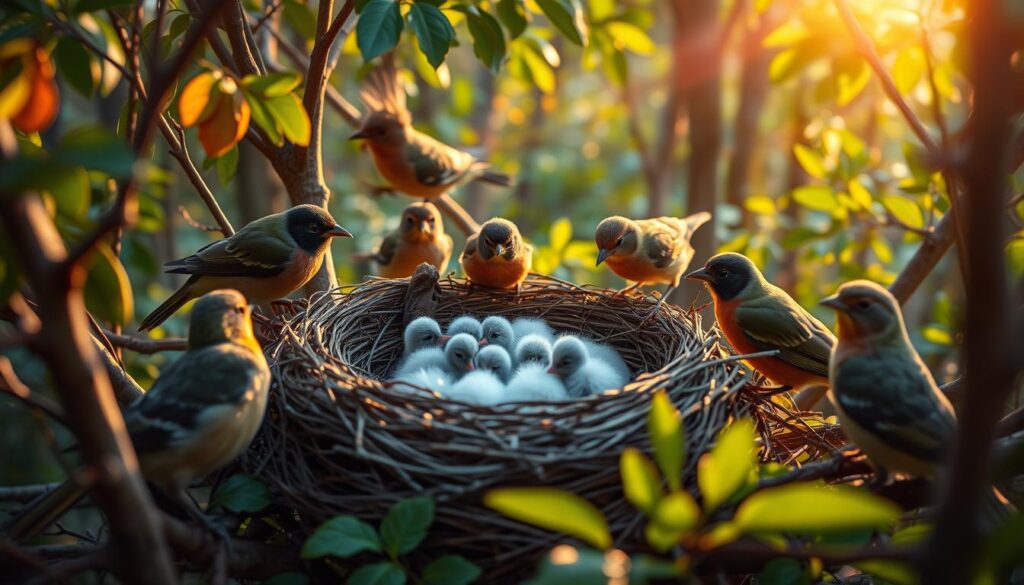
Environmental factors like temperature and predators affect bird care. Nest construction helps save energy and protect young from threats. Female birds can also choose the gender of their offspring to help them survive.
“Nest predation and mortality rates in birds can be around 50-78%, making parental care a critical factor in the survival of nestlings.”
In summary, bird parental care and nestling growth are complex and varied. They show the different ways birds adapt to their environments. Understanding these relationships helps us see the amazing ways birds care for their young.
Survival Challenges for Nesting Birds
When birds start nesting, they face many dangers. These dangers can harm their survival and the success of their young. The main challenges are predators and environmental factors.
Predator Threats
Nesting birds are more likely to be attacked because of their increased activity and calls. Shorebirds and seabirds on beaches are at risk from raccoons, foxes, and humans. Wading birds on coastal islands may leave their nests if people get too close.
Environmental Factors
Weather, food shortages, and human disturbance are big risks for nesting birds. Extreme weather can destroy nests and harm eggs and chicks. Food scarcity makes it hard for parents to feed their young. Humans and pets near nests can also cause birds to leave their homes.
To help nesting birds, we need to act. We can protect them by creating safe areas, teaching people, and reporting disturbances. This way, we can ensure their survival during their most vulnerable times.
| Nesting Bird Species | Conservation Challenges | Recommended Actions |
|---|---|---|
| Snowy Plover, Least Tern, Black Skimmer, American Oystercatcher, Wilson’s Plover | Facing population declines due to predation, human disturbance, and habitat loss | Maintain a distance of at least 300 feet from nesting sites, report any disturbances to the FWC’s Wildlife Alert Hotline |
| Reddish Egret, Tricolored Heron, Roseate Spoonbill | Experiencing population declines, impacted by natural disasters like Hurricane Irma | Support conservation efforts through the Florida Shorebird Alliance, volunteer for coastal bird stewardship programs |
| Common Tern | Populations have declined by nearly 80% since the late 1970s | Participate in beach-nesting bird monitoring and protection initiatives in New York and New Jersey |
By understanding the challenges nesting birds face and taking action, we can help them survive. This way, we ensure these amazing creatures stay in our ecosystems.
Migration’s Impact on Nesting Schedules
Migratory birds carefully plan their arrival at breeding grounds for the best nesting conditions. This timing is key for their survival and successful breeding. But, climate change is making it harder for them to match their nesting with food availability.
Over 650 species of North American breeding birds, more than half migratory, travel long distances. About 350 species migrate from the U.S. and Canada to Central and South America for winter.
Their migration patterns are shaped by genetics, environment, and adaptability. Changes in daylight often start their migration.
| Migration Type | Description |
|---|---|
| Permanent Resident | Birds that stay in the same place all year round, not engaging in migration. |
| Short-Distance Migrant | Birds that make relatively small movements, such as from higher to lower elevations. |
| Medium-Distance Migrant | Birds that cover distances spanning a few hundred miles. |
| Long-Distance Migrant | Birds that typically move from breeding grounds in the United States and Canada to wintering grounds in Central and South America. |
The timing of migratory bird arrivals is crucial for nesting success. For example, Red-winged Blackbirds in central New York arrive within two weeks with great precision. But, climate change is disrupting this timing, affecting their access to food and resources.
Research shows most North American bird species arrive at their nesting grounds about one to two days earlier each decade. This change, caused by climate change, makes it harder for them to find food and resources for breeding.
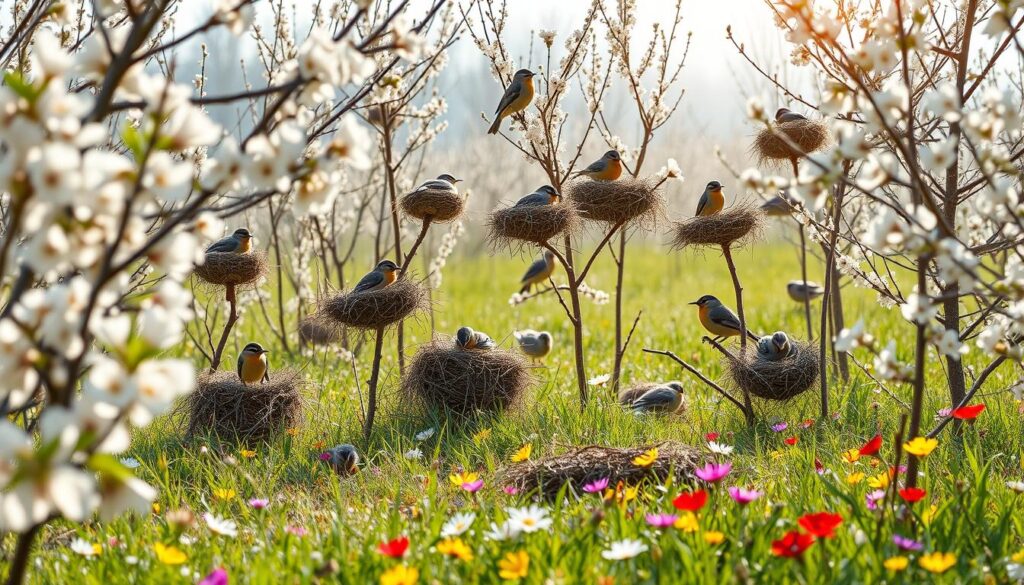
Climate change’s impact on migratory bird nesting is significant and complex. As temperatures rise, these birds face challenges in adapting. This highlights the need for conservation and understanding the links between migration, nesting, and nature.
Climate Change Effects on Bird Nesting
Climate change is affecting how birds nest. It’s changing their breeding cycles. This means some birds are nesting earlier, while others struggle to adjust.
In the Chicago area, a study found that one-third of 72 bird species are nesting 25 days earlier than before. This change is linked to more carbon dioxide in the air over the last 150 years.
Climate change isn’t just about earlier nesting. A 2019 study in Science showed that nearly 3 billion birds have disappeared in the U.S. and Canada since 1970. This decline might be due to climate change.
A 2019 study in Ecology Letters found that birds are getting smaller but their wings are getting longer. This could be how they adapt to changing environments.
| Nesting Impact | Key Findings |
|---|---|
| Earlier Nesting |
|
| Population Decline |
|
| Adaptive Changes |
|
Researchers are watching how climate change affects bird nesting. It’s important to understand these changes to protect bird populations as the environment changes.
“Extreme climate events, specifically cold snaps and heat waves, were especially detrimental when occurring between egg hatching and nestlings fledging.”
Conclusion
Learning about bird nesting seasons is key for bird nesting conservation and avian breeding protection. Different birds nest in unique ways, showing how complex bird reproduction is. As the environment changes, especially with climate change, protecting nesting spots and adjusting conservation plans is vital.
Some birds start nesting early, like Great Horned Owls and Bald Eagles. Others nest later, and some even raise more than one brood. But, threats like predators, lost habitats, and environmental stress can harm their nests and young.
Knowing what each bird species needs helps us tailor conservation efforts. Protecting their nesting sites and keeping disturbances low is crucial. This way, we can help bird populations thrive for years to come. As our environment keeps changing, protecting birds and their habitats is more important than ever.
FAQ
When is the typical nesting season for birds?
Birds nest at different times, depending on their species and where they live. Most nest in the spring. They choose this time because of more daylight and plenty of food.
What factors influence the timing of bird nesting seasons?
Several things affect when birds nest. Daylight hours, food, climate, and what each bird needs are important. More daylight and food help birds nest and raise their young.
How do nesting patterns differ for early and late season breeders?
Some birds, like Great Horned Owls, start nesting in winter. This gives their young a head start. Others, like American Goldfinches, wait until summer or fall. Many birds can have more than one brood in the spring.
What role does daylight play in bird breeding cycles?
More daylight hours make birds ready to breed. It makes their reproductive organs grow and changes their hormones. It also helps them find and defend their nesting spots.
How do birds construct their nests and what materials do they use?
Birds build nests in many ways and with different materials. Some make simple nests on the ground, while others build complex ones in trees or on buildings. They use grass, leaves, mud, and even human items.
How do clutch sizes and incubation periods differ across bird species?
Clutch sizes vary a lot, from 1-2 eggs in some birds to 15 in waterfowl. Food, where they live, and the female’s age can affect this. Incubation times also vary, usually based on the bird’s size.
What threats do nesting birds face?
Nesting birds face many dangers. Predators, bad weather, not enough food, and humans disturbing them are big threats. These dangers can make it hard for birds to nest successfully.
How is climate change affecting bird nesting patterns?
Climate change is changing when birds nest. Warmer springs can make it hard for birds to find food when they need it. Some birds nest earlier, but others struggle to adjust to these changes.
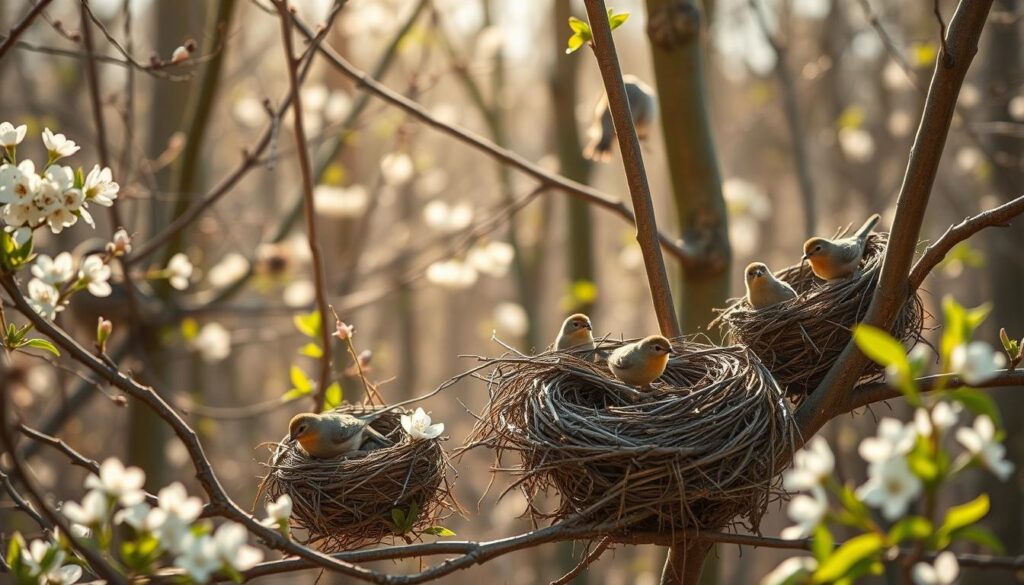

Muchas gracias. ?Como puedo iniciar sesion?
I am really inspired together with your writing skills as neatly as with the layout to your blog. Is that this a paid theme or did you modify it yourself? Anyway keep up the excellent high quality writing, it’s uncommon to see a great weblog like this one these days!